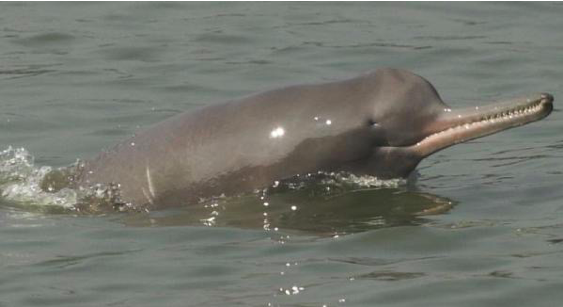Written by Jennifer Austin, Sea Watch Research Intern 2015. BSc Marine Biology, Plymouth University. My final year thesis was a population comparison of sperm whale lengths from acoustic data, but I have a personal interest in river dolphins since working with them in the Amazon back in 2012.
Many people have heard of the critically endangered Vaquita dolphins, with 200 individuals left in the Gulf of California, or the Maui’s dolphins in New Zealand, where the population has declined to fewer than 60 individuals. What we don’t hear about are the river dolphins in the Ganges. Surveys in 2014 reported the best estimate of the Ganges River dolphin population to be less than 30 individuals. The dolphins were once abundant, but due to habitat destruction, destructive and intensive fishing and industrial run-off the species has decreased over 96% since 2012. In comparison, that’s equivalent to more than 20.5 million people dying in the UK every year (over 800 times the average rate).
The Ganges River dolphin reaches 2.5m with a long beak and teeth which can be seen even when the mouth is shut. The teeth are thin and pointed when the calf is born and can be up to an inch long. Over time the teeth are flattened into square disks from use. They have many adaptations for their river environment, including a reduced dorsal fin in form of a triangular bump so they can squeeze through small gaps in between trees. Most cetaceans have a fused cervical vertebrae, restricting their neck movement, but river dolphin’s top vertebrae are unfused allowing them to be flexible and swim through the flooded forest and swim on their sides. All river dolphins lack what most mammals consider a vital body part: the crystalline lens. This is a transparent part of the eye that works with the cornea to focus light on the retina. Without this, it causes the dolphins to be fairly blind in the murky waters, and as compensation for this they have a prominent melon which increases the directionality of their acoustics.
In 2012 I carried out a survey on 100 people (aged 16-70), to investigate the public’s knowledge of river dolphins. 90% said they believed river dolphins receive little conservation due to “lack of public awareness”. If people don’t know, they can’t care or take action. The majority of people had never heard of the baiji river dolphin, which went extinct in 2006 mostly due to habitat destruction and dam construction. It seems we have learnt nothing from the extinction of one river dolphin and without immediate extreme conservation efforts the Ganges River dolphin will almost certainly fall extinct this century.
Humans have long since been using rainforests and river systems for food, power, wealth and travel. With increasing need for these and with advances in technology, more and more development continued to expand the uses of the environment. The largest threat to the Ganges River dolphin is the creation of dams. Within its habitat, over 50 dams have been constructed, including the Tehri Dam which is the 5th largest in the world. It is part of a project in which the Indian government planned to link 37 major rivers through a series of dams and canals. This water withdrawal from the river has caused the Ganges River to be within the top ten rivers at risk of over-extraction worldwide.
On July 26th 2015 (only days after the estimate of 30 individuals was publicised) the Indian government announced a clean-up effort of the Ganges River, starting with a survey of the Ganges River dolphins.
“This is the first time a unified survey will be done for an aquatic animal [in India]. It has been done for elephants and tigers but this is more complicated,” Dr Sandeep Behera (consultant for the government’s National Mission for Clean Ganga) reported. “We are doing the survey in winter, when water levels drop and we can capture numbers in small isolated pockets and get a good idea of the population.”
After the survey they hope to identify the hot spots and give those areas protection and priority. Although 450 volunteers will be surveying the smaller tributaries, which has not been done previously, they are subtly leaving the Brahmaputra River out of the survey, where a large number of the population can be found. In April 2009 over 200 Ganges River dolphins were found in a survey of the Brahmaputra River, so the accuracy of their survey results without this river is questionable. It is a step in the right direction, but it could still be too late for the Ganges River dolphin.
We must ensure the loss of two river dolphins causes increased conservation efforts for the boto (Amazon River dolphin), and the Indus River dolphin, which would be the two only true freshwater dolphin species left in the world.

























